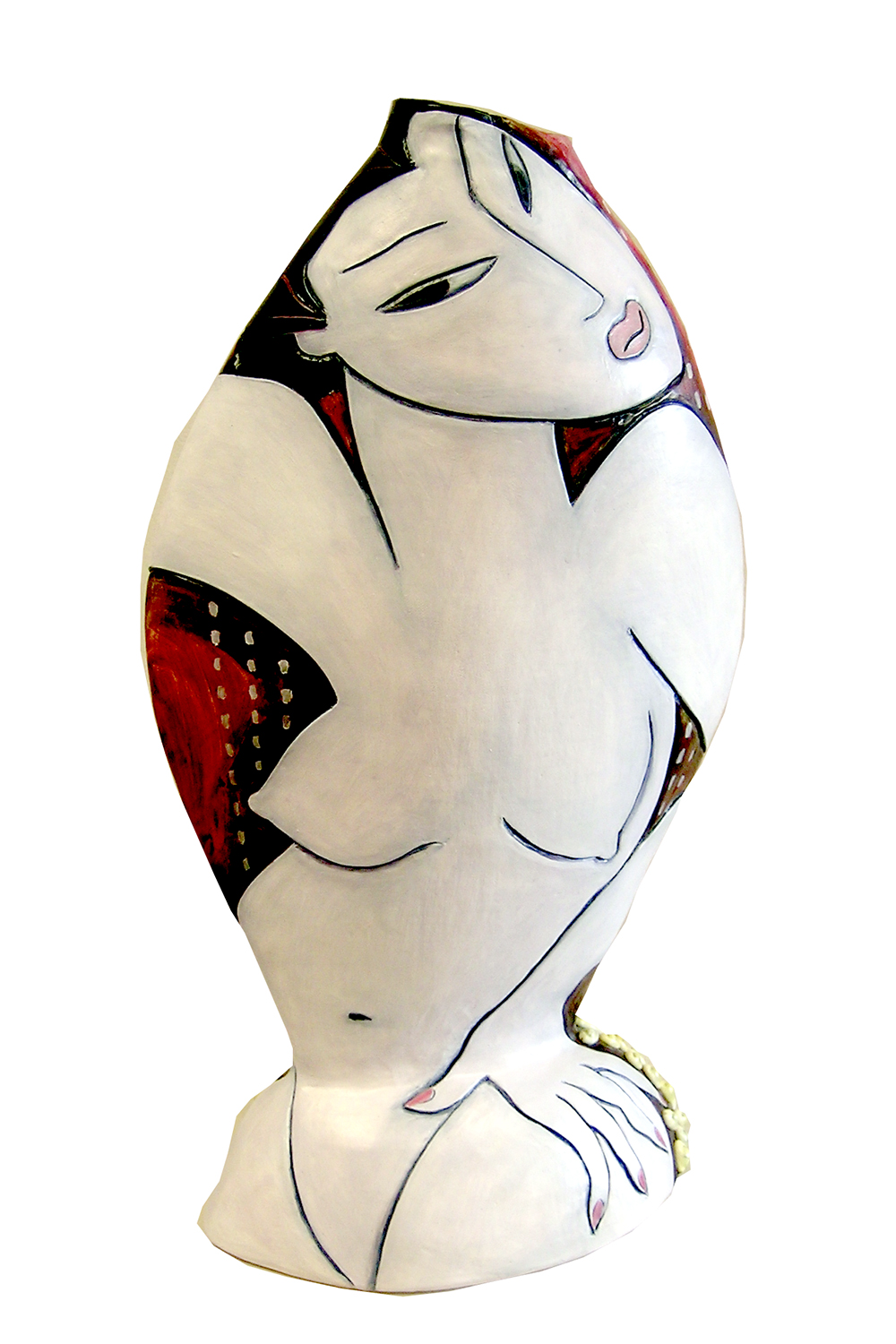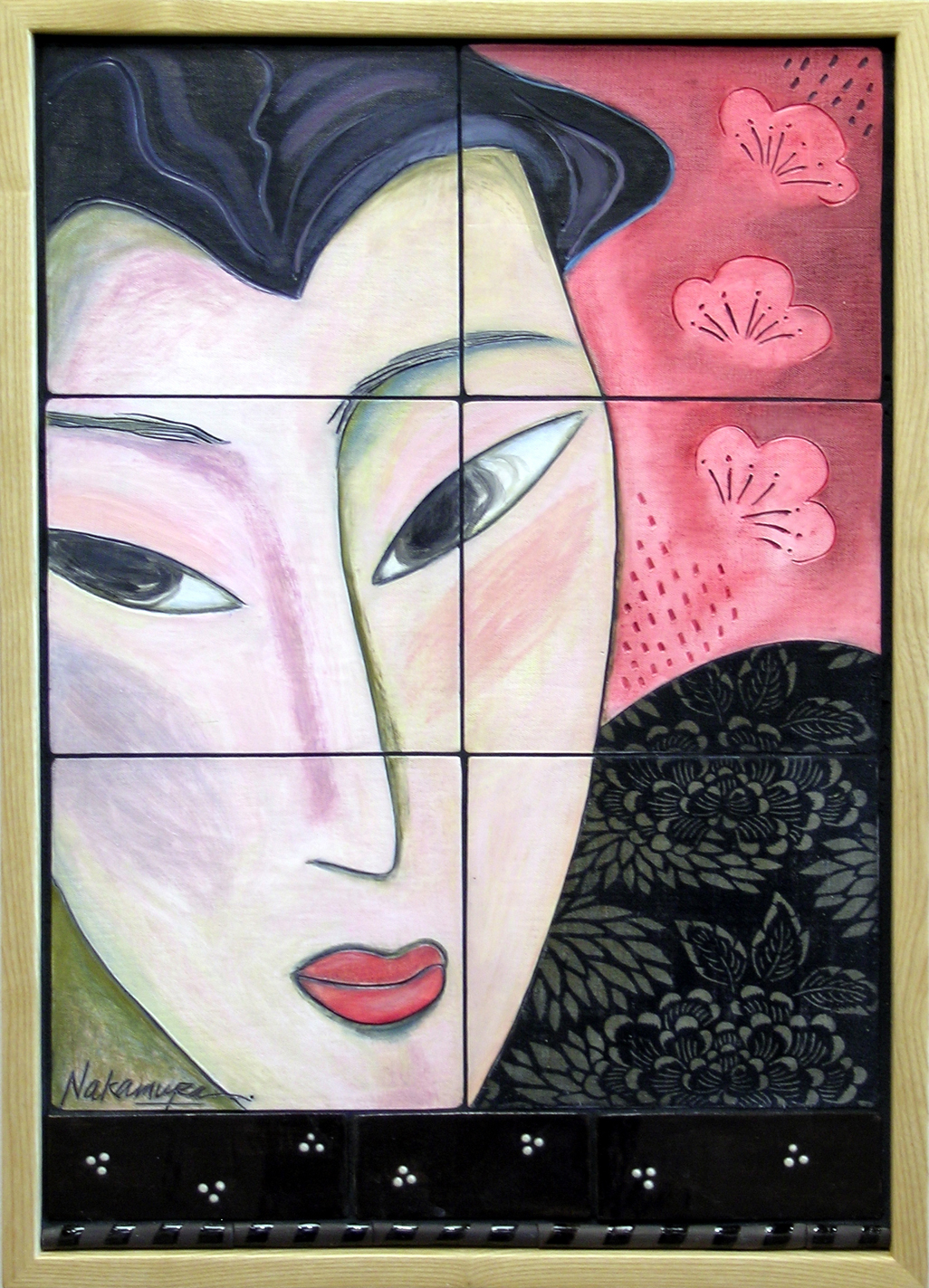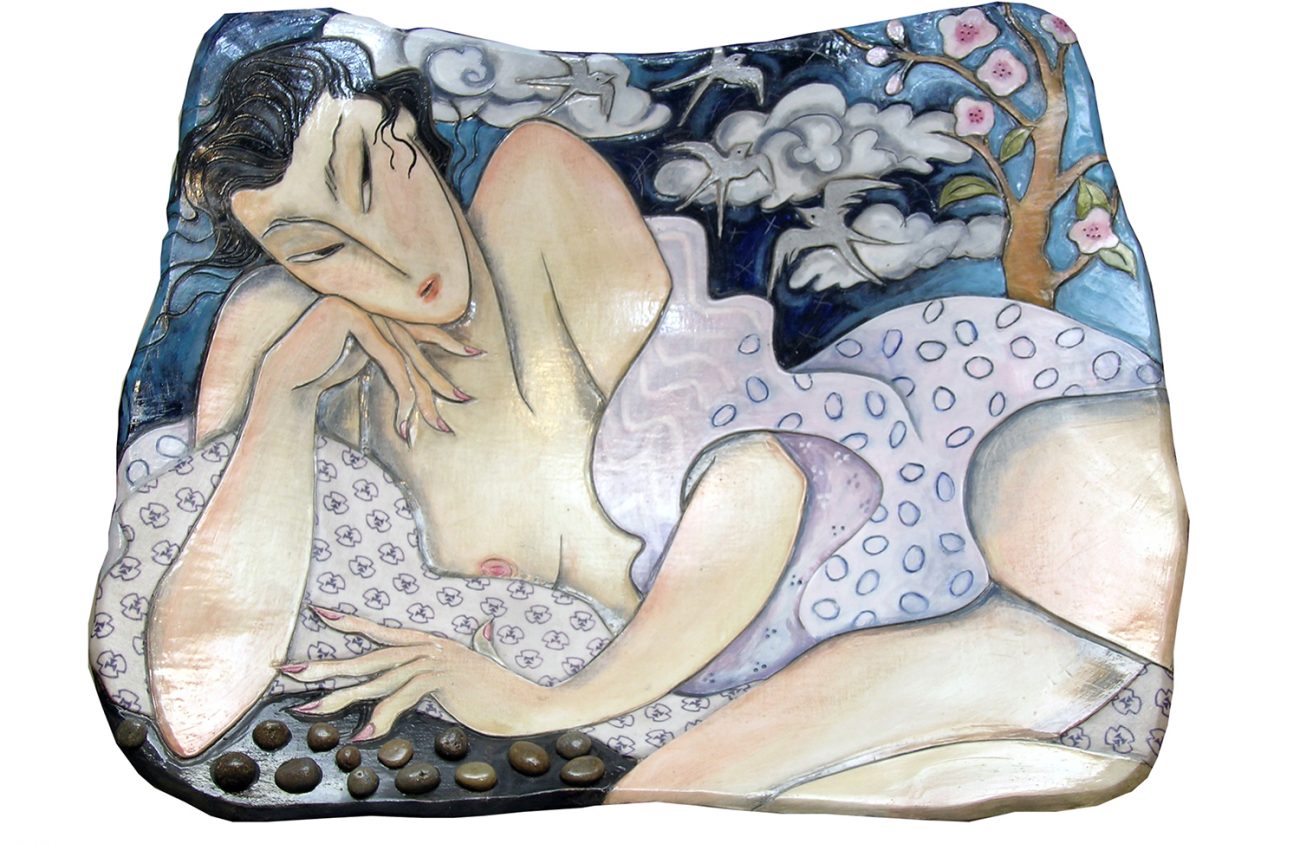“Painted Clay” by Faye Nakamura, Aug. 31 – Oct. 2. Karin Clarke Gallery, 760 Willamette, Eugene.
Ceramist and artist Faye Nakamura’s fine show at Karin Clarke Gallery celebrates an established artistic sensibility openly embracing new techniques and materials. Both the generous details and the wholeness of Nakamura’s vision are present in the works created during the four months of preparation for the show.
“I work in a spiral,” Nakamura said in an interview this week. “I might have 20 pieces going at a time.” She arranges and rearranges the tile sets that are present in almost all the work. “I can spend the whole day carving for the tile assemblages,” she said. “The tile sets are like paintings to me. I try them in one place then change them the next day.”
That’s also the way she works with the vintage fabrics that are artfully used in many works in the show. “I’ve collected fabric since I was in high school,” Nakamura said, although the fabrics she uses in this show have been acquired more recently, both in Eugene and Hawaii, where she spends the winter. The kimono fabrics and the obi (sashes) put a traditional touch to the work.
Painting on porcelain is new for Nakamura. “Once you fire clay, that’s it,” she said. “I love paint because you can change it.”
Enlarge

She uses a very high temperature for her glazed pieces, but the colors are not bright. “I saw someone paint on ceramics a long time ago,” she said. “I always liked those brilliant colors.” Nakamura works until she gets her painting the way she likes it. But she said she still allows herself to make corrections if her mood changes.
“The most fun I have is at the end when I’m trying to fit all the pieces together, like a puzzle,” she said. “I strive to find the best arrangement.”
Her design skills are evident in each piece. The red and white abstract design of the vintage obi adds texture and interest to the woman and her three red dogs in Sitting with Basenjis (glazed and oil painted tiles with vintage obi). The black tiles that frame the complicated image are mirrored in the black and white vase holding Oregon pussy willows. The female figure is painted on many individual tiles, her unity created by the viewer.
In Roses (glazed tile), the row of nine tiny, pale pink, erotic rosebuds enhance the effect of the standing figure’s tinted cheeks, nipples, mouth and fingernails. Pale blue tiles behind the figure add to the delicacy of the work, while black and white tiles form its borders.
Nakamura’s virtuosic abilities are reflected in the multi-faceted Rengetsu Piece (glazed and oil painted tile with fabric and rice paper). Classic cherry blossoms like those found in Japanese woodblock prints arch over the sleeping figure of a woman. She is covered by a patterned blanket and protectively surrounded by layers of tiles — above, below and on both sides. A line drawing of a large house, maybe an inn, floats, dream-like in the distance. A dark fabric under the reclining figure anchors the body to the earth. The piece is filled in, with no large blank spaces, but its design doesn’t feel busy but comfortably cozy. Here, as in many of Nakamura’s best work, the artist taps into the archetypal, for surely this sleeping woman is dreaming. I fell under the potent spell of this piece both times I lingered to look at it.
This happened each time I studied Silver Birds, a large glazed and painted ceramic platter in front of the gallery office. Here the oversized reclining figure has slipped into reverie, which combined with the sloping shape of the vessel, pulls the viewer into her dream. The piece is painted to its edges as well. Above the figure are a blue sky, stylized clouds, silver birds in flight and a flowering cherry tree. (The name “silver birds” comes from Arthur Golden’s 1997 novel, Memoirs of a Geisha.)
Silver birds also appear in the stand-alone triptych, Other Worldly, oil painted ceramics with pebbles. Again, the blue sky, clouds and birds point back to traditional woodblock prints, as does the voluptuous figure wearing a kimono decorated with fish. A pensive dog sits to one side, and the woman reaches for the pebbles with her feet on the other.
Enlarge

Face, glazed and painted tile with vintage fabric, is a close-up of a woman’s face. Nakamura adds a dark opulence to the painting by using a black textile with a lightly colored floral design, which is the result of a wax-resist technique.
My favorite single piece might be another complex work, The Reader, oil painted tile with fabric and rice paper. The colors range from the bright green, narrow shades behind the figure, who’s draped in a pink covering, to the hint of dark red and green on the gossamer leaves of the beige silk fabric. Textures are many, from the woman’s smooth skin to the parchment pages of the book she’s reading to the varied floor coverings and her rattan sandals.
Now that the show is up, Nakamura has returned to creating tableware for her winter studio sale, which she said “will have leftovers, but not gallery pieces. I need the balance of making production work,” she said. Gallery work is exhausting, in part because she doesn’t know when to stop. “I get obsessed,” she said. “I start by quitting work at 12, then at 1, then 2, 3 … then I pull an all-nighter.” She laughs. “I lead a privileged life,” she said.
Nakamura said people often assume that she is the model for the feminine figure she paints. “She’s not me,” the artist said, “but I can relate to her. I’ve always drawn people, since I was a 5 year old. I have an affinity for the body.”
Nakamura received her BFA in ceramics from the UO in 1977. She grew up in Hawaii but said there wasn’t a lot of Japanese art in her mother’s home. She discovered Japanese woodblock prints later. “I loved the sense of space in them,” she said. “I loved how the figures are in that space.” But Nakamura doesn’t think of her work as “Asian,” although she has “learned to appreciate Japanese arts and crafts” and to use them in her work.
Among the objects that have appeared in her work for 30 years are the dark-leafed ferns called lau-ae or lauai, which are prominent in the large glazed ceramic platter titled Lauai and Willows. Besides the stylized cherry blossoms that bring their own femininity to her work, Nakamura frequently uses pussy willows, which she associates with Oregon and loves for their metamorphosis and tactility.
Variations on a theme and metamorphosis are both ways to describe the timeless quality of Nakamura’s studies of the eternal feminine. Grace and beauty shine from her work. If you are in town on Saturday, stop in the gallery and treat your senses to the pleasure of this delightful show.
